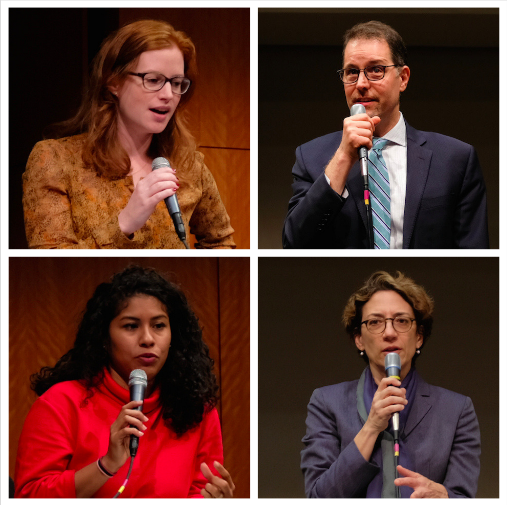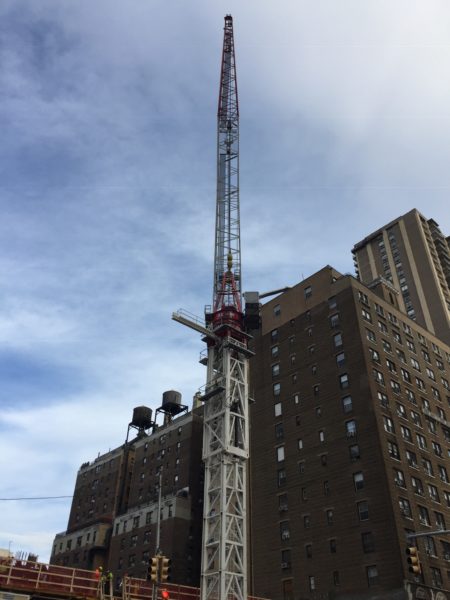
Clockwise from top left: Sarah Meyer, Mark Levine, Polly Trottenberg and Stephanie Burgos-Veras. Photos by Michael McDowell.
By Michael McDowell
Bus-riders, bike-riders, straphangers, pedestrians and drivers all seem to agree on one thing: it’s no picnic getting around the city these days. Those struggles took center stage at a packed transportation town hall hosted by Councilman Mark Levine at the Manhattan School of Music in Morningside Heights on Monday night.
New York City Transportation Commissioner Polly Trottenberg, MTA Chief Customer Officer Sarah Meyer, and State Senator Brian Benjamin, who represents much of Upper Manhattan, were joined on stage by transit advocates Stephanie Burgos-Veras of the Riders Alliance; Hayley Richardson of TransitCenter; and Erwin Figueroa of Transportation Alternatives.
The discussion ranged from the airing of individual grievances to wide-ranging ideas about how officials should best use New York’s scarce streets and parking spaces as the city nears nine million residents.
“We’re in the midst of a crisis, folks, a transportation crisis [and] a congestion crisis,” Levine began, and sketched several proposals he argues will support mass transit and alleviate traffic.
“I am a huge proponent of congestion pricing,” Levine said, to applause. “It would generate about a billion dollars a year to shore up our mass transit, it would be a long-term stable source of revenue, and it would reduce congestion.”
Levine also recently introduced a bill that would create residential parking permits in Northern Manhattan (covering all of the borough north of 60th Street), and is a supporter of shared mobility programs like CitiBike, as well as the city’s pilot carshare program with Zipcar and Enterprise.
Another ambitious idea? Extending ferry service up the Hudson.
“We need ferry service. We’re 8 minutes from Edgewater, we have potential ferry landings up and down the Hudson River, from Dyckman Street, Riverdale, other places, and I see ferry service as a way to further reduce congestion on our streets, so that people who right now are taking their cars across the George Washington Bridge would have a green alternative.”
Commissioner Trottenberg also answered a range of questions, saying that the city is aware of the abuse of city-issued parking placards, and is looking at the introduction of residential parking permits—be careful what you wish for—the recent citywide cordoning off of bus shelters, and the addition of dedicated bus lanes to city streets.
Bus advocates in particular made their presence felt. Burgos-Veras of Riders Alliance called bus service “the ignored transit crisis in New York City,” and described a novel technology solution her organization is supporting that is meant to improve bus commute time by safely moving buses through intersections.
“What we have been calling for, on the city side, are enforced bus lanes and Transit Signal Priority [TSP], a technology in streetlights that can communicate with a bus, so as a bus approaches a light turning red, the bus can communicate with the light, which will then hold the light green so that the bus can cross.”
There is an important role for those who support buses to play in the fight to improve bus service, added Richardson, of TransitCenter.
“How do we get more bus lanes? The best thing that anybody here could do is to show up to a community board meeting and say ‘Yes, we want bus lanes!’ Because usually the people who show up don’t want the bus lanes. It may not be the way you want to spend a Tuesday night, but you can play a huge role in getting more bus lanes.”
Select bus service lanes have been implemented in some parts of the city, though their effectiveness has been questioned. Trottenberg does hope, however, that 96th Street will become an SBS route.
Despite the skepticism of some audience members toward bicycles and bicyclists, Trottenberg and Levine both reiterated their support for bike lanes, and in particular a controversial redesign of Amsterdam Avenue from 110th Street to 162nd Street.
Will we see a protected bike lane on Central Park West?
“We’re evaluating it right now,” Trottenberg responded.
“I support it,” Levine added.
Meyer shed some light on the recent renovations of local subway stations—no elevators were installed—as well as the potential reopening of sealed station entrances.
The Upper West Side’s 110th Street-Cathedral Parkway station, which recently reopened after several months of repair and renovation, did not get any accessibility improvements, and still lacks an elevator. One person asked if Meyer could explain the MTA’s plan for accessibility improvements there and throughout the system.
“The 110th Street station was renovated as part of a program called the ESI program, which is a new program, revolutionary by MTA standards, to get in and get out in record time, and ensure that the station was in a state of good repair, that the platform edge was stable, that leaking was taken care of. Elevators were never part of that program,” Meyer explained.
“The good news is, as part of the Fast Forward Plan we are working to ensure that within five years another 100 elevators would be commissioned, so that you would be no more than two stops away from an accessible elevator.”
MTA President Andy Byford’s Fast Forward Plan is a proposed effort to revitalize New York’s mass transit that is expected to cost $30 billion or more. Meyer highlighted its key priorities: transform the subway, re-imagine the bus network, focus on accessibility, and engage and empower MTA employees. It’s not yet clear how it would be funded.
Levine asked Meyer if the MTA plans to reopen previously sealed station entrances, especially at stations like 103rd Street on the B and C line, which has only one entrance for both uptown and downtown trains.
“That is definitely something we’re looking at,” Meyer answered. “The new tap-and-go payment system, which is coming online, will allow us to open more entrances.”
The contactless fare system will enable riders to use a phone app or smart card, and is set to replace MetroCard next spring.
Speaking of construction, Meyer mentioned that the agency is working to add shuttle buses—which replace subway routes during construction—to its transit apps over the next few months.
A few questions veered into existential territory. Like: “Why are sirens so loud?”
Apparently, the noise is associated specifically with ambulances at St. Luke’s, on Amsterdam Ave. and 114th Street. Levine and State Senator Benjamin promised to talk to the hospital about the issue.
Also in attendance was NYPD Captain Lourdes Soto, of Manhattan’s 30th Precinct, who encouraged the audience to add police community council meetings—held on the fourth Thursday of each month at the precinct—to their calendars. “We’re here for you,” she said.
The town went well over time, but the crowd was by no means ready to disperse, and those who had not yet expressed their concerns descended on the stage en masse.
“Traffic has slowed appreciably on the Upper West Side, and it’s very difficult to sit here, and hear, ‘Well, it’s actually moving better,’” one man sighed.







We already have congestion pricing – it is the existing tolls on bridges and tunnels to get to Manhattan. Tolls should be added to East River crossings to be equitable. Any form of street based tolling would be double taxation and would create chaos at the border blocks.
Parking permits are a great idea. It will raise a lot of money by monetizing a limited resource. And those who game the system by registering their cars elsewhere will be forced to register here, generating even more money (though that goes to the state).
Quite contrary, congestion pricing is an excellent idea that has worked everywhere it was introduced. The alternative is to completely close certain roads/areas for traffic. Given the ever increasing use of those streets, traffic is now unacceptably slow, cost for upkeep and fixing of the streets is rising, as is pollution.
While calling it double taxation is a bit far fetched (you’re paying for the use and upkeep of a scarce good; bridge toll is for the bridge, not for the use of the congested streets), I agree though with adding a toll to the east river bridges.
If you’re driving a car, you know very well that there would be no chaos at the congestion pricing borders given the technology already in use at the likes of triboro or the henry hudson bridge.
Cursing Ubers and the like have exponentially increased traffic congestion everywhere. It’s time to tax Uber for the chaos they cause. Before sinking millions into ferries, how about fixing the buses and subways we have. Just a thought!
One of the things that bothers me about Congestion Pricing is that it imposes a fee for the use of public space. This, of course, results in the limiting the use of public space to those who can afford it, and denies it to those who can’t.
Making it a place that’s inaccessible to those without The Money.
I agree but unfortunately that is the goal of the DeBlasio Administration no matter what he says.
Yes to residential parking permits. There is actually plenty of parking here for residents. We know this because during snowstorms all the traffic from Jersey ceases and there’s ample spaces. During normal weather, they come here and squat for 3 days.
Not sure it’s accurate to say that there are enough parking spaces since space opens up when a snow storm is predicted because squatters move cars back to NJ. Many locals pay to put their cars in garages when a storm is coming.
What’s needed is: More bikes, more bike lanes.
Less stupidity from the “anti-bike” crowd
Dear Lord (Of The Slice),
So if we pedestrians will get on board with the idea that we need “More bikes, more bike lanes” and “Less stupidity from the “anti-bike” crowd” can you please tell us if there is any chance … any … that we can get cyclists to obey the rules and laws of the road – say for instance, stopping at red lights?
We know they are annoying and that they slow a cyclist’s roll but cars have to stop at ’em and we walkers gotta wait for the green.
So just be honest with us, we can take it. If the answer is no then say so but if it’s yes please tell us what to do.
Enforcement of current bus lanes by the NYPD would improve service dramatically.
Re: ““How do we get more bus lanes?”
And HOW do we get to keep Uber, Lyft, Via, yellow cabs, green cabs, FedEx, UPS, and assorted delivery trucks OUT OF THE BUS LANES?!?
Try taking a bus on any avenue or major crosstown street (esp.57th) and count the numbers of these vehicles illegally blocking bus stops and/or bus lanes. You’ll run out of fingers pretty fast. And no one, not even NYPD-traffic, seems to do anything about it.
Instead of fancy-shmancy stuff like “Transit Signal Priority” why not just outfit every bus with a license-plate-reading-camera (activated by the driver) so that the offenders can be identified and ticketed by mail.
Seems like a good solution, no? Which is why it probably never will be adopted.
Bikes and bike lanes are not a solution to this issue. Many people (people with kids in tow, the elderly, and disabled people) cannot use bicycles. THEY are the people using the bus to begin with. But I agree, accommodating single-occupant vehicles is not the answer. Still crossing my fingers for person-sized pneumatic tubes.
Will you need to own a car to apply for a parking permit? I live in the neighborhood and have as much right as anyone to those public parking spots. I choose not to own a car, but I would love to sell my permit to someone who could use it. It doesn’t make sense to give away valuable public resources to UWSers who own a car – on average they are a well to do group.
actually, from an economic perspective, Josh is being entirely consistent. he is “begruding” a de facto subsidy being distributed disproportionately to upper income people, and is proposing a market-based alternative that would probably be fairer.
Bruce, but living from an economic perspective denies your humanity.
Right, I’ve noticed you’re a great defender of market solutions, Bruce.
i appreciate your publishing your question. i would never have thought of it myself, but it became immediately obvious to me, and totally valid. and important.
geoff, you could be a Parking Scalper!
I see it for you.
Wow Josh … this comment is realllllllllllly something
So you begrudge people who have some money and now you want to monetize the residential parking permit for your personal benefit. Interesting logic.
I would say the permits should be non-transferable to anyone without a 10025, 10024 or 10023 residence. The bar code on the registration sticker should make this easy for enforcement agents.
A parking space in a garage is worth ~$500/month. I don’t think it makes any sense for the city to just give away $500 worth of free services to some people in the neighborhood and not others. The distribution of these permits won’t be based on need or income. It’s compeltely arbitrary who benefits. It’s unfair and I hope this unbelievably greedy money grab never gets passed.
Josh, there are public amenities available to citizens for their use. There are sidewalks, parks, streets, schools, etc.
Not every person uses all of these amenities. For example some have no children to use the schools. Each pays however for the common good. That is what make a society.
Do you believe that a childless person should be able to sell “their” school spot to someone out of their district or their system? And where does this stop?
Here we go again. A parking spot on the street — subjected to rain, snow, vandalism — is worth LESS than a sheltered spot in a garage. By quite a lot. Why do people keep peddling this nonsense?
Most big cities already issue permits. NYC is the laggard. It’s not a giveaway at all, the giveaway occurs right now in that the city reaps nothing from street parking (aside from metered spaces). The losers in this scenario aren’t people like you, the losers are the people from NJ and CT who come here and gobble up spaces. I’d suggest directing your ire at them.
Folks always mention more enforcement by NYPD. They just don’t have the time and/or man power to do this every day. The same folks will never support an expansion of the NYPD to its needed size for all the additional duties it is daily asked to cover
If there is to be a protected bike lane on Central Park West, than I hope the bikers need to become licensed and respect pedestrians. I have found bikers in NYC to be absolutely the worst in respecting others, following rode etiquette and rules, most have no regard for anyone.
You mean they act like pedestrians?
Get rid of the bike lanes, bikers are worse than taxi drivers. Instead of doing cosmetic fixes to the stations, fix the signal problems that constantly delay service.
What a disaster! No wonder New Yorkers are leaving the city in droves while the folks from the suburbs, many of whom own cars are pouring in. Bike lanes are absurdly underused and are cutting off space for buses. How is it that the 2/3 and 1 trains show up every 5 minutes on average and the buses that accommodate the elderly, people with disabilities and those living on the far west side have to wait forever for a bus.. Two seats in a bus-shelter for 15 people waiting for buses at 72nd and Broadway.
Where was MTA President Andy Byford? Wonderful man with amazing foresight and energy. Makes me wonder is this transit situation will ever be resolved. Or in fact if our leaders are even remotely able to do a damn thing to restore this 100 year old system. If it can run efficient in every major town in the rest of the world, how come nothing gets done here?
“Andy Byford? Wonderful man with amazing foresight and energy.” Yes a fine looking and well-meaning person.
“Makes me wonder is this transit situation will ever be resolved.” – No it won’t. Once that becomes apparent the Wonderful Man will be gone from here.
“Or in fact if our leaders are even remotely able to do a damn thing to restore this 100 year old system.” – You know that your Governor, who runs it all, hates the subway (and riders), right?
“If it can run efficient in every major town in the rest of the world, how come nothing gets done here?” – Well clearly there’s more money in letting things go downhill. And the power players don’t get nuthin’ for fixing this.
The fix is in.
Again
Congestion charging? Not until after the number of bus runs are doubled and subway runs are increased by 50%. You cannot force people out of vehicles if mass transit is inadequate. [Service cut-backs since 1961 is approximately 55% for subway runs and 72% for bus runs.]